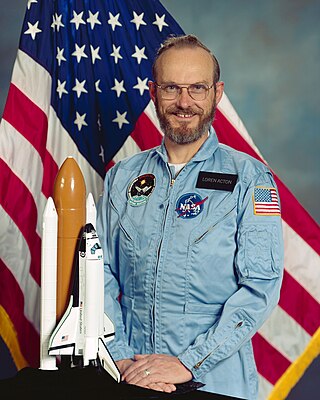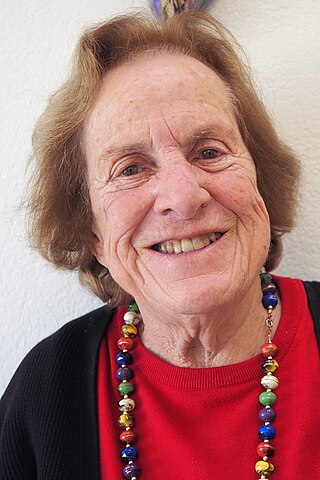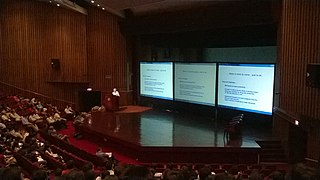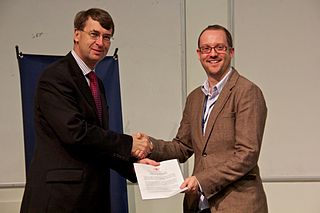Related Research Articles

Sunspots are phenomena on the Sun's photosphere that appear as temporary spots that are darker than the surrounding areas. They are regions of reduced surface temperature caused by concentrations of magnetic flux that inhibit convection. Sunspots appear within active regions, usually in pairs of opposite magnetic polarity. Their number varies according to the approximately 11-year solar cycle.

The Maunder Minimum, also known as the "prolonged sunspot minimum", was a period around 1645 to 1715 during which sunspots became exceedingly rare. During a 28-year period (1672–1699) within the minimum, observations revealed fewer than 50 sunspots. This contrasts with the typical 40,000–50,000 sunspots seen in modern times over a similar timespan.

Loren Wilber Acton is an American physicist who flew on Space Shuttle mission STS-51-F as a Payload Specialist for the Lockheed Palo Alto Research Laboratory. He is also the father of Cheryll Glotfelty, a leading ecocritic.

The solar cycle, also known as the solar magnetic activity cycle, sunspot cycle, or Schwabe cycle, is a nearly periodic 11-year change in the Sun's activity measured in terms of variations in the number of observed sunspots on the Sun's surface. Over the period of a solar cycle, levels of solar radiation and ejection of solar material, the number and size of sunspots, solar flares, and coronal loops all exhibit a synchronized fluctuation from a period of minimum activity to a period of a maximum activity back to a period of minimum activity.
Richard Christopher Carrington was an English amateur astronomer whose 1859 astronomical observations demonstrated the existence of solar flares as well as suggesting their electrical influence upon the Earth and its aurorae; and whose 1863 records of sunspot observations revealed the differential rotation of the Sun.

John Allen "Jack" Eddy was an American astronomer. He studied historical sunspot records, and popularised the name Maunder Minimum for the sunspot minimum which occurred in the late 17th century.

Solar minimum is the regular period of least solar activity in the Sun's 11-year solar cycle. During solar minimum, sunspot and solar flare activity diminishes, and often does not occur for days at a time. On average, the solar cycle takes about 11 years to go from one solar minimum to the next, with duration observed varying from 9 to 14 years. The date of the minimum is described by a smoothed average over 12 months of sunspot activity, so identifying the date of the solar minimum usually can only happen 6 months after the minimum takes place.
Solar physics is the branch of astrophysics that specializes in the study of the Sun. It deals with detailed measurements that are possible only for our closest star. It intersects with many disciplines of pure physics, astrophysics, and computer science, including fluid dynamics, plasma physics including magnetohydrodynamics, seismology, particle physics, atomic physics, nuclear physics, stellar evolution, space physics, spectroscopy, radiative transfer, applied optics, signal processing, computer vision, computational physics, stellar physics and solar astronomy.

Joan Feynman was an American astrophysicist. She made contributions to the study of solar wind particles and fields, sun-Earth relations, and magnetospheric physics. In particular, Feynman was known for developing an understanding of the origin of auroras. She was also known for creating a model that predicts the number of high-energy particles likely to hit a spacecraft over its lifetime, and for uncovering a method for predicting sunspot cycles.
Eigil Friis-Christensen was a Danish geophysicist specializing in space physics.

Solar cycle 24 is the most recently completed solar cycle, the 24th since 1755, when extensive recording of solar sunspot activity began. It began in December 2008 with a minimum smoothed sunspot number of 2.2, and ended in December 2019. Activity was minimal until early 2010. It reached its maximum in April 2014 with a 23 months smoothed sunspot number of 81.8. This maximum value was substantially lower than other recent solar cycles, down to a level which had not been seen since cycles 12 to 15 (1878-1923).
An active region is a temporary region in the Sun's atmosphere characterized by a strong and complex magnetic field. They are often associated with sunspots and are commonly the source of violent eruptions such as coronal mass ejections and solar flares. The number and location of active regions on the solar disk at any given time is dependent on the solar cycle.

Indian Institute of Science Education and Research Kolkata is an autonomous institute in science and education field located in Mohanpur near the town of Kalyani in Nadia, West Bengal, India. It was established by the Ministry of Education, Government of India in 11 July 2006 and promoted to the status of an Institute of National Importance in 2012 vide the NIT Amendment Act. It is one of seven Indian Institutes of Science Education and Research, and was one of the first IISERs to be established along with IISER Pune. It is considered to be one of the leading institutes of India in terms of research output. In 2022, it was ranked fourth among the academic institutions in India by the Nature Index in 2022

Professor Bhagavatula Dattaguru is an Indian engineer and academic. He has received several awards, including the Padma Shri Award, India's fourth highest civilian honour in 2005 in the field of science and engineering.

Vijyoshi is an annual national science camp in India organised by KVPY in collaboration with INSPIRE programme, IISc Bangalore and IISER-Kolkata. It is an abbreviation for Vigyan Jyoti Shivir. It started in the year 2009 and is funded by the Department of Science and Technology (India). The aim of Vijyoshi Camp is to provide a forum for interactions between bright young students and leading researchers in various branches of Science and Mathematics.

Solar cycle 25 is the current solar cycle, the 25th since 1755, when extensive recording of solar sunspot activity began. It began in December 2019 with a minimum smoothed sunspot number of 1.8. It is expected to continue until about 2030.
Solar observation is the scientific endeavor of studying the Sun and its behavior and relation to the Earth and the remainder of the Solar System. Deliberate solar observation began thousands of years ago. That initial era of direct observation gave way to telescopes in the 1600s followed by satellites in the twentieth century.

Solar phenomena are natural phenomena which occur within the atmosphere of the Sun. These phenomena take many forms, including solar wind, radio wave flux, solar flares, coronal mass ejections, coronal heating and sunspots.

Mathew Owens is a British physicist and professor of space physics at the University of Reading in the UK. He has made major contributions to the understanding of the solar wind and space weather.

Dr Natchimuthuk "Nat" Gopalswamy is an Indian American Solar physicist. He is currently a staff scientist at the Heliophysics Division of NASA’s Goddard Space Flight Center.
References
- ↑ "Resume" . Retrieved 12 June 2012.
- 1 2 Evelyn Boswell (19 January 2012). "Fourth solar physicist affiliated with MSU wins national prize". MSU News Service. Retrieved 12 June 2012.
- ↑ "Powerful 'conveyor belts' drive Sun's 11-year cycle, new evidence suggests". NASA. 19 June 2003. Retrieved 12 June 2012.
- ↑ Srinivas Laxman, TNN (3 March 2011). "Indian-led research tells world how Sun lost its spots". The Times of India . Archived from the original on 3 January 2013. Retrieved 12 June 2012.
- ↑ "Kolkata scientist clears up mystery of sun spots". The Hindu . 4 March 2011. Retrieved 12 June 2012.
- ↑ "NASA, India sponsored research explains missing sunspots". IBN Live. 3 March 2011. Archived from the original on 26 January 2013. Retrieved 12 June 2012.
- ↑ "NASA explains sun's record energy low". KPCL TV News. 28 October 2011. Retrieved 12 June 2012.